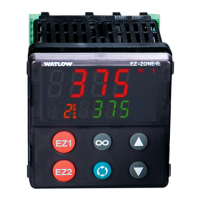Watlow EZ-ZONE
®
PMI Controller • 211 • Chapter 9 Features
• Attribute ID (1 to 255)
EtherNet/IP and DeviceNet are both based on CIP and use the same addressing scheme. In
the following menu pages notice the column header identied as CIP. There you will nd the
Class, Instance and Attribute in hexadecimal, (decimal in parenthesis) which makes up the
addressing for both protocols. The Watlow implementation of CIP does not support connect-
ed explicit messages but fully supports unconnected explicit messaging.
Rockwell Automation (RA) developed the DF1 serial protocol within the framework of the
PCCC application protocol. With the introduction of CIP, the PCCC protocol was encapsulated
within it to enable continued communication over Ethernet to the legacy RA programmable
controllers, e.g., SLC, Micrologic and PLC-5 controllers equipped with Ethernet capabilities.
The Watlow implementation of CIP also supports the PCCC protocol.
EtherNet/IP (Industrial Protocol) is a network communication standard capable of handling
large amounts of data at speeds of 10 Mbps or 100 Mbps, and at up to 1,500 bytes per pack-
et. It makes use of standard off-the-shelf Ethernet chip sets and the currently installed phys-
ical media (hardware connections). DeviceNet was the rst eld bus offering of the ODVA
group and has been around for many years. DeviceNet can communicate at 125, 250 and 500
kilobytes per second with a maximum limitation of 64 nodes (0 to 63) on the network.
Note:
If the control is brought back to the factory defaults (See Appendix: CIP Implicit Assembly
Structures) the user configured assemblies will be overwritten.
Note:
The maximum number of implicit input/output members using DeviceNet is 200. When us-
ing EtherNet/IP the maximum is 100.
CIP Implicit Assemblies
Communications using CIP (EtherNet/IP and DeviceNet) can be accomplished with any PM
Integrated control equipped with either DeviceNet or EtherNet/IP communications cards. As
was already mentioned, reading or writing when using CIP can be accomplished via explicit
and or implicit communications. Explicit communications are usually executed via a message
instruction within the PLC but there are other ways to do this as well outside of the focus of
this document.
Implicit communications is also commonly referred to as polled communications. When us-
ing implicit communications there is an I/O assembly that would be read or written to. The
default assemblies and the assembly size is embedded into the rmware of the PM control.
Watlow refers to these assemblies as the T to O (Target to Originator) and the O to T (Origi-
nator to Target) assemblies where the Target is always the EZ-ZONE PM controller and the
Originator is the PLC or master on the network. The size of the O to T assembly is initially
set to 40 (32-bit) members where the T to O assembly consists of 40 (32-bit) members. All
assembly members are user congurable with the exception of the rst T to O member. The
rst member of the T to O assembly is called the Device Status, it is unique and cannot be
changed. If the module has been properly congured when viewing this 32-bit member in
binary format bits 12 and 16 should always be set to 1 where all of the other bits should be
0. All other members that follow Device Status are user congurable. The Appendix of this
User's Guide contains the PM implicit assemblies (See Appendix: CIP Implicit Assembly Struc-
tures).

